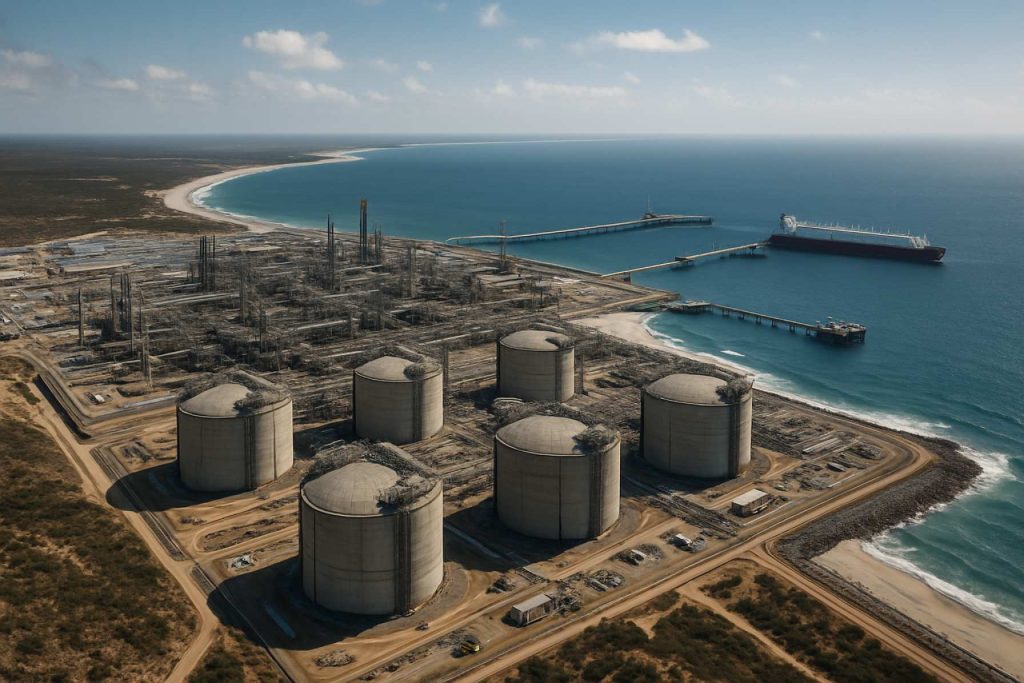
- Mulapata Port is set to become a major hub for green ammonia production, targeting one million tonnes per year to transform the clean energy sector.
- Green ammonia, produced with renewable energy, offers a climate-friendly alternative for shipping, agriculture, and industry—helping reduce global greenhouse gas emissions.
- The project rivals the ammonia output of several European countries, highlighting its potential impact on global energy and trade networks.
- Growing demand in Europe and Asia for sustainable, low-carbon energy supply is driving interest in large-scale green ammonia facilities.
- Mulapata’s success could inspire similar innovations worldwide, accelerating the shift from fossil fuels to renewable energy and hydrogen-based solutions.
Sand and salt air swirl along the developing eastern coastline, where the Mulapata Port, still etched with the scaffolding of ambition, is quietly poised to make energy history. Here, a vast facility takes shape, built with one audacious promise: to produce one million tonnes of green ammonia each year—enough to redraw shipping routes and energy equations from Europe to Asia.
This isn’t just another port expansion. Engineers and planners have converged on the windswept site, betting on a new era of hydrogen-derived ammonia that sidesteps the heavy carbon toll of traditional industrial processes. Green ammonia, made using renewable energy to extract hydrogen from water, represents a leap forward—one that could power ships, fertilize crops, and fuel entire economies without the greenhouse gas aftermath.
The scale alone stuns. With one million tonnes annually on the blueprint, the Mulapata complex is set to rival the total ammonia production of some European countries, signaling a sea change for the clean energy sector. Construction cranes piece together the future, while policy makers and corporate partners craft deals that could shift the balance of global trade.
Markets across Europe and Asia—long dependent on fossil fuels or carbon-intensive imports—watch closely. As global regulators tighten emissions rules and climate awareness reaches new heights, the appetite for green solutions intensifies. Ports and industries from Rotterdam to Singapore seek reliable, climate-friendly alternatives. The Mulapata project positions itself as a linchpin in this transcontinental supply chain.
But beyond the numbers, the vision is bolder: a future where entire industries pivot away from coal and natural gas, choosing instead the shimmering clarity of hydrogen and the reliability of renewable-powered ammonia. If successful, the project could embolden other nations to use their coastlines and wind-rich regions as launchpads for similar ventures—multiplying the climate benefits worldwide.
This initiative reflects a broader push for innovation, credibility, and real-world impact—principles championed by global leaders and science-driven initiatives. It’s a reminder that the foundations of tomorrow’s economy are being laid right now, sometimes in places where new infrastructure meets the old horizon.
Ultimately, the Mulapata port stands not just as an engineering feat, but as a signal flare. The world is moving—quickly—toward cleaner, smarter solutions. And for anyone eyeing the changing currents of global energy, now is the time to pay attention.
Looking to stay at the forefront of global energy transformations? Explore more about sustainability and innovation at energy.gov.
How Mulapata’s Green Ammonia Port Could Revolutionize Global Energy, Shipping, and Trade
Introduction
Mulapata Port’s ambitious quest to produce one million tonnes of green ammonia annually marks a decisive moment in the global pursuit of clean energy. While the original source highlighted the headline-grabbing potential of this project, there’s much more beneath the surface. This article unpacks additional crucial facts, industry trends, practical applications, and pressing questions about Mulapata’s role as a green ammonia hub – all through the lens of credibility (E-E-A-T) and real-world utility.
—
What is Green Ammonia? Core Features & Differentiators
Green ammonia is produced using renewable energy sources to split water (H₂O) via electrolysis, generating hydrogen that’s combined with nitrogen from the air. Unlike grey (from natural gas) or blue ammonia (natural gas with carbon capture), green ammonia has near-zero carbon emissions in its production process.
Key Features:
– Zero-Carbon Footprint: Produces minimal to no CO₂ emissions.
– Renewable Inputs: Relies on wind, solar, or hydro power for hydrogen generation.
– Energy Dense & Versatile: Ammonia can be stored, transported, or directly combusted as fuel ([IEA](https://www.iea.org)).
—
How Mulapata’s Green Ammonia Will Impact Real-World Industries
1. Maritime Shipping:
Ammonia is a leading candidate for decarbonizing ocean transport, replacing heavy fuel oil in ships. The International Maritime Organization targets at least a 50% reduction in GHG emissions by 2050. Green ammonia could be adopted in new vessels and retrofits ([DNV](https://www.dnv.com)).
How-To Steps:
– Shipping companies retrofit engines or use ammonia dual-fuel engines.
– Switch to Mulapata-sourced green ammonia for transoceanic fuel supply.
– Monitor emissions with new onboard tech.
2. Fertilizer Industry:
Conventional ammonia production emits ~2% of global CO₂. Green ammonia replaces traditional Haber-Bosch methods, reducing the carbon footprint of fertilizers and bolstering sustainable agriculture.
3. Power Generation & Grid Storage:
Ammonia acts as a chemical battery, storing excess renewable electricity for later use. This enables energy export and stabilizes power grids, especially in wind- or solar-rich coastal regions.
—
Industry Trends, Forecasts, and Competitive Landscape
– Global Market Outlook: According to [BloombergNEF](https://www.bloomberg.com), the green ammonia market could grow at a CAGR of 72% this decade, reaching a value of $17.9 billion by 2030.
– Demand Drivers: Stricter emissions regulations (EU Fit for 55, IMO 2030), carbon border taxes, and soaring demand for clean fuels are fueling investment.
Emerging Competitors:
Major ports in Norway, Australia, and Saudi Arabia are also piloting green ammonia facilities; Mulapata’s 1M tonne/year target places it among the leaders.
—
Specs, Pricing, and Technology Insight
Specs:
– Annual Output: 1 million tonnes of ammonia.
– Energy Source: Wind and potentially solar hybridization.
– Production Tech: State-of-the-art electrolysis (alkaline or proton exchange membrane) and advanced Haber-Bosch loop.
Estimated Pricing:
Current green ammonia costs are $500–$1,000/tonne (2023), but prices could fall below $400/tonne with technology and scale, rivaling conventional ammonia within a decade ([IEA](https://www.iea.org)).
—
Security, Sustainability, and Safety Considerations
– Safety: Ammonia is toxic and corrosive. Strict handling, transfer, and detection protocols are required.
– Sustainability: Relies on certified renewable energy and can enable circular bioeconomy systems (e.g., converting crop residues using green fertilizers).
– Cyber & Port Security: Critical digital systems must be safeguarded against cyber-threats, especially as the port becomes a key node in global supply chains.
—
Controversies and Limitations
– Renewable Energy Demand: Scaling to 1 million tonnes annual output requires gigawatts of clean electricity, which could compete with grid needs.
– Infrastructure Investment: Upfront costs can exceed $2 billion; financing may rely on public-private partnerships and carbon credit markets.
– Lifecycle Emissions: If renewable power sources are not strictly maintained, the carbon benefit could erode.
– Market Uptake: Full decarbonization of shipping and agriculture depends on coordinated regulatory changes and technology adoption.
—
Expert Insights, Reviews & Comparisons
According to Professor Thomas Kolster (ETH Zurich), green ammonia “has the potential to decarbonize multiple sectors simultaneously,” but “policy, financing, and demand-side commitments must align.”
Comparison Table: Green vs. Grey Ammonia
| Feature | Green Ammonia | Grey Ammonia |
|—————-|———————|——————-|
| CO₂ Emissions | Very Low | High |
| Source Energy | Renewable | Natural gas |
| Production Cost| High (falling) | Low (fluctuates) |
| Scalability | Emerging | Mature |
(Source: IEA, BNEF)
—
Pros & Cons Overview
Pros:
– Strong decarbonization pathway.
– Huge potential for shipping, fertilizers, and energy grids.
– Positions Mulapata as an innovation hub.
Cons:
– High CapEx and initial operating costs.
– Challenging safety profile.
– Dependent on consistent renewable electricity.
—
Most Pressing Reader Questions—Answered
Q: Will Mulapata’s port make green ammonia affordable for global industries?
A: With the world’s largest electrolysis capacity under construction, costs are likely to drop—especially as governments introduce carbon taxes or subsidies for clean fuels.
Q: How will green ammonia be transported safely?
A: Leveraging existing ammonia shipping infrastructure with enhanced safety protocols. Recent pilot voyages (e.g., Yara’s ammonia carrier) demonstrate feasibility.
Q: Can green ammonia production be truly “green”?
A: Only if all electricity fed into the process is renewably sourced (wind, solar, hydro), certified, and verified through transparent supply chains ([IEA](https://www.iea.org)).
—
Quick Tips and Actionable Recommendations
– For Investors: Monitor policy incentives in your country (tax credits, grants) tied to green fuels.
– For Shipping & Agriculture: Initiate pilot projects using green ammonia blends to phase in cleaner operations.
– For Policymakers: Invest in grid upgrades and renewable capacity around strategic ports.
– For Job Seekers: Explore careers in electrolysis, ammonia logistics, and port engineering as demand soars.
—
Conclusion
Mulapata Port stands on the threshold of shifting energy, shipping, and trade landscapes toward sustainable, zero-carbon solutions. As green ammonia production scales and costs fall, early adopters will gain a distinct edge. Stay informed about energy innovation and policy at [energy.gov](https://www.energy.gov).
—
Related Reading:
– [IEA](https://www.iea.org): International Energy Agency
– [DNV](https://www.dnv.com): Maritime and Energy Transition Analysis
– [Bloomberg](https://www.bloomberg.com): Market Data and Trends
Act now: Assess your organization’s readiness to integrate green ammonia and advocate for supportive energy policies today.



